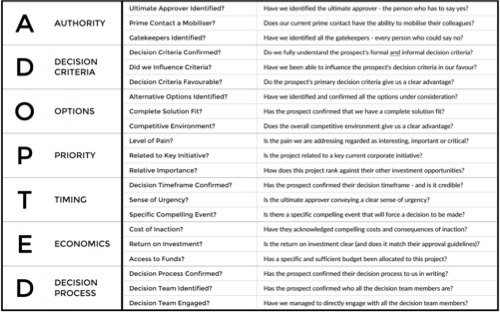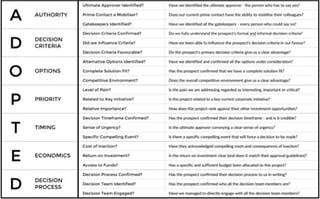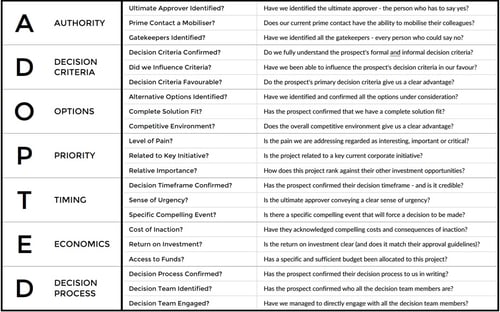ADOPTED: a far better way to qualify complex sales opportunities
August 17, 2016

 One of the fundamental capabilities that distinguish top sales people - and top sales organisations - from the rest is their ability to accurately qualify sales opportunities from a relatively early stage in the sales process.
One of the fundamental capabilities that distinguish top sales people - and top sales organisations - from the rest is their ability to accurately qualify sales opportunities from a relatively early stage in the sales process.
Effective qualification is important in any sales environment, but it’s absolutely critical in high-value complex sales situations with multiple stakeholders, where man-months of precious resource can easily be wasted pursuing opportunities that were never likely to buy anything or if they did, were never likely to buy from us.
Traditional approaches to sales qualification - like the over-simple BANT (Budget, Authority, Need and Timeframe) are utterly inadequate to reflect the dynamics of today’s complex sales opportunities. Fortunately, there are far better ways of dealing with the issue…
Our ultimate goal, of course, is to identify well-qualified opportunities where our solution stands an excellent chance of being ADOPTED by our prospect if we pursue an effective sales strategy. The clue, of course, is in the capitalisation - because I believe that ADOPTED is an excellent acronym to guide our qualification process.
ADOPTED stands for:
- Authority
- Decision Criteria
- Options
- Priority
- Timing
- Economics
- Decision Process
Let’s break down each of these elements into their constituent elements:
AUTHORITY
- ULTIMATE APPROVER - have we identified and engaged with the person (or people) who has to say yes?
- MOBILISER - Is our current prime contact someone who is capable of creating a ‘coalition of the willing’ and mobilising their colleagues to make a buying decision?
- GATEKEEPERS - have we identified and engaged with all the gatekeepers - the people who could say no?
DECISION CRITERIA
- CRITERIA - do we fully understand the prospect’s decision criteria - both formal and informal?
- INFLUENCE - have we managed to influence the prospect’s decision criteria in our favour?
- FAVOURABLE - do the prospect’s decision criteria give our solution a clear advantage?
OPTIONS
- ALTERNATIVES - have we identified and confirmed all the alternative options (both direct and indirect competition) that the prospect is considering?
- SOLUTION FIT - has the prospect confirmed that we have a complete solution fit?
- COMPETITIVE ENVIRONMENT - does the overall competitive environment give us a clear advantage?
PRIORITY
- LEVEL OF PAIN - Is the pain we are addressing regarded as interesting, important or critical?
- KEY INITIATIVE - is the project related to a key current corporate initiative?
- RELATIVE IMPORTANCE - how does this project rank against their other investment opportunities?
TIMING
- TIMEFRAME - has the prospect confirmed their decision timeframe - and is it credible?
- URGENCY - is the ultimate approver conveying a clear sense of urgency?
- COMPELLING EVENT - is there a specific compelling event that will force a decision to be made?
ECONOMICS
- COST OF INACTION - have they acknowledged compelling costs and consequences of sticking with the status quo?
- ROI - is the return on investment for the project clear (and does it match their investment approval guidelines)?
- ACCESS TO FUNDS - has a specific and sufficient budget been allocated to this project?
DECISION PROCESS
- DECISION PROCESS CONFIRMED - has the prospect confirmed their detailed decision process with us?
- DECISION TEAM IDENTIFIED - has the prospect confirmed who all the decision team members are?
- DECISION TEAM ENGAGED - have we managed to directly engage with all the decision team members?
Here are all the qualifying criteria on a single page (you'll find a link to download a copy of the spreadsheet at the end of this article):

A CONTINUOUS PROCESS
Qualification is a continuous process, and it should be obvious that not all of these factors can be assessed in a first discussion with a potential prospect. But we need to establish deadlines related to the progress of every opportunity through our defined sales stages by which each specific aspect must have been assessed.
It should also be obvious that in complex lengthy sales any of these factors can change for the better or the worse at any point in the sales cycle. I strongly recommend that you get every sales person to reassess every aspect of every opportunity before advancing the deal from one stage to the next.
ADDITIONAL QUALIFIERS
Although the evidence is that most or all of the above factors are central to the accurate qualification of all complex sales opportunities, when you assess your sales successes and failures you may well identify additional factors that are specific to your sales environment - in which case you should add them to your sales opportunity qualification checklist.
BACKED BY EVIDENCE, NOT INTUITION
These judgements need to be based on fact, not supposition. It’s awfully easy for sales people to assume that a situation is positive simply because they have no evidence to the contrary. In fact, fear of hearing the “wrong” answer can often mean that the right question isn’t asked in the first place.
These untested assumptions are incredibly dangerous. We need to insist that our sales people document the evidence to support their judgements - otherwise qualification becomes a “tick box” exercise that is completed at speed and without the necessary thought or rigour. We cannot afford to qualify opportunities this way.
SIMPLE JUDGEMENTS
I’ve seen other opportunity qualification schemes incorporate complicated, multi-level scoring systems for each element, but it’s almost impossible to achieve consistency. I’ve concluded that a simple rating of each criteria along the following lines is sufficient:
- FAVOURABLE: we have assessed the situation, and this factor is strongly favourable to our chances of winning or the chances that the deal will happen - and our judgement is backed by evidence
- NEUTRAL: we have assessed the situation, and this factor is neither strongly favourable nor strongly unfavourable to either our chances or the chances that the deal will happen
- UNFAVOURABLE: we have assessed the situation, and this factor is unfavourable to our chances of winning or the chances that the deal will go ahead at all
- UNKNOWN: we have not yet had an opportunity to assess this factor
Depending on your situation, having just one unfavourable factor - if critical to the decision - might be enough to qualify an opportunity out, or at the very least to proceed with caution. Having any remaining unknowns once the opportunity has reached the “Selecting” or equivalent stage is another clear red flag.
IMPACT ON THE PIPELINE
There is a clear and predictable outcome of subjecting all active opportunities to this level of rigour: the value of the sales pipeline will initially appear to shrink (sometimes dramatically) - but the truth is that most of the excluded or demoted opportunities should never have been allowed to reach that stage in the pipeline anyway.
But after a while, the pipeline values will inevitably recover - and a number of other positive effects will be seen as well. Win rates will inevitably increase and sales cycles will inevitably shorten (because we’re giving the right level of attention to the opportunities we can win) and forecast accuracy will improve.
That - to me - feels like more than enough justification to adopt a more rigorous approach to opportunity qualification. Have I missed anything fundamental? Could ADOPTED work in your environment? Here's that link to the spreadsheet. Let me know how you get along with it...
This article was originally published on LinkedIn.
About Bob
A fellow of Association of Professional Sales, Bob Apollo is the founder of UK-based Inflexion-Point Strategy Partners. He works with ambitious B2B-focused organisations that have complex sales environments, enabling them to establish consistently scalable sales and marketing machines that deliver predictable revenue outcomes. Follow him on Twitter at @bobapollo.
Related Articles


Comments